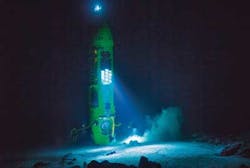DeepSea Challenger records 3D video of Earth's ocean
On March 26, 2012, James Cameron successfully piloted the DeepSea Challenger submersible to the Mariana Trench's lowest point, the Challenger Deep, which lies 6.83 miles below the ocean surface. A 3D documentary of the mission—which was dedicated to the advancement of the world's understanding of the ocean's biological and geological phenomena—will be released this fall.
For the project, Cameron and his team used a number of different cameras. First, an Epic camera from Red (Hollywood, CA, USA; www.red.com) was mounted directly in front of the small viewport in the pilot sphere's hatch. This camera captured IMAX-quality, 5k-raw images.
Inside the DeepSea Challenger, two HD cameras were used to capture images of the pilot. On the outside of the submersible, two mini HD cameras also capture 3D video. These cameras are housed in titanium and are smaller than a soda can. Two more cameras were also mounted on the wrist of the sub's manipulator arm. While one uses a wide-angle lens, the other features a macro lens for imaging close-ups of small animals.
For the two HD external cameras that are being used to capture 3D, as well as the two external 2D mini-cams, M3-F focus modules from New Scale Technologies (Victor, NY, USA; www.newscaletech.com) were chosen to remotely focus the lenses.
"The M3-F was the final piece of the puzzle, providing a compact solution for achieving remote focus control," said Adam Gobi, technical project lead for cameras and imaging on the DeepSea Challenger and president of Go Beyond Consulting (Othello, WA, USA; www.gobeyondconsulting.net).
"The size of the M3-F makes it unique. It gave us the performance needed for 3D imaging application, where left and right camera focus must be perfectly matched," he says.
The DeepSea Challenge is a joint scientific expedition by James Cameron, the National Geographic Society, and Rolex. Cameron was the sole occupant in a complex, 24-foot-long craft. The dive itself lasted 70 mins, but Cameron spent hours maneuvering along the ocean floor filming unexplored terrain.
Vision Systems Articles Archives

